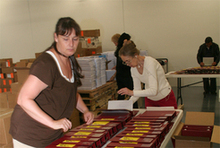15 Jun 2010, Silver Spring, Maryland, United States…Elizabeth Lechleitner/ANN
Next week, more than 2,400 Seventh-day Adventist Church delegates will choose their church’s top leadership for the next five years. They’ll also vote on myriad other agenda items, ranging from the church’s administrative structure to changes in its manual.
When delegates arrive in Atlanta, Georgia for the General Conference Session, their first order of business will be electing church leadership, starting with the president of the world church and including the presidents of each of the church’s 13 world regions, as well as department directors at world church headquarters and their regional counterparts.
While electing church leaders might be among the most anticipated tasks at the Session, most elections take place during the first few days of the 11-day business meeting, leaving the rest of the time for reports from the church’s regions and institutions and other agenda items.
Perhaps most noteworthy, said world church undersecretary Larry Evans, is an agenda item that, if passed, would shift the election of departmental associate directors from Session to the first church business meeting afterward.
Given the volume of elections voted at Session, the nomination process can seem rushed, Evans said, leaving some delegates wishing for more time to consider potential nominees.
The move “would allow more input to be given in finding complementary departmental associates,” Evans said. “It gives newly-elected department heads time to really shape a department. As it is, he or she is elected and has only a day to pick two associate directors.”
With new technology at church leaders’ disposal, delegates will also vote on whether members of church executive committees — both at world church headquarters and their regional counterparts — can officially attend meetings via conference call, Web cam or another method that allows members to hear each other simultaneously.
Delegates will also consider the composition of church executive committees. They’ll decide whether the world church’s Executive Committee should include more young adults and lay people, such as pastors, teachers and missionaries. One agenda item asks delegates to require current Executive Committee members to add “no less than 15 and no more than 20” new members from “among laity, including young adults.”
An overhauled Church Manual is up for consideration at Session as well. Delegates, who each received a copy of proposed revisions in mid-May, will vote whether to approve the changes.
At a church business meeting in 2008, delegates first voted to appoint a study group to review the current Church Manual, last revised in 2005, for “style and cohesiveness,” the Session agenda states.
Striving for a more concise Manual, the group rearranged chapters, reorganized paragraphs and sentences, eliminated duplicate quotes and wording, added Bible texts and quotes, included references to departmental resources and websites and updated the wording to accommodate modern media forms.
The group also added specific language guiding the appointment of church employees and volunteers who work closely with minors, designed to keep children and other vulnerable individuals safe. Those involved in work with children — including in Pathfinders, Vacation Bible School, Children’s Ministry and Sabbath School programs — “must meet church and legal standards and requirements, such as background checks or certification,” the revision states.
Language guiding the cases of former sexual offenders is added to the Manual’s section outlining how those who have been removed from membership can be restored. “Restoration of membership does not remove all consequences of such a serious violation,” the section reads, adding that those “convicted or disciplined” for sexual abuse should never hold a position allowing them “unsupervised contact” with children and other vulnerable individuals.
While such guidelines may not have been outlined in the Church Manual until now, they are not new practices for the church, said Rosa Banks, a world church associate secretary instrumental in drafting protocol for dealing with sexual misconduct and child abuse beginning in 1991, when the church in North America first addressed abuse issues.
“The church has been actively involved in implementing policies and guidelines that protect children from offenders for almost 20 years now,” Banks said. Including in the Church Manual guidelines already in practice in many church regions serves to reinforce their relevance on a global scale, she added.
The revised Church Manual also introduces a glossary of frequently used terms, including a definition of “union of churches,” a church governance structure in which a group of local congregations reports directly to a union, eliminating the conference or mission level of administration. Delegates will approve several recently formed unions of churches at Session, as well as consider whether to expand the structure’s use.
